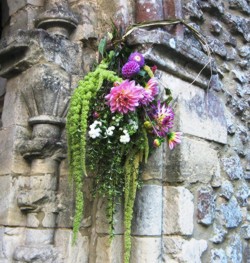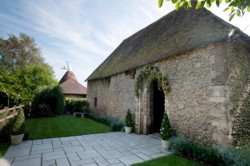
Newlands Chapel is the oldest building in Charing. During Saxon times the area was part of the Calehill One Hundred in the Lathe of Scray. The Manor of Calehill which sat on the hills to the South and the families residing there, were significant. “This district during the time of the Saxons belonged to one of their princes named Lalethe, of whom it was purchased by Archbishop Ceolnoth in 839, and given to the monks of Christ Church, and with the consent of King Ethulwulf, who declared it to be free from all secular service and regal tribute excepting the repelling of invasions and the reparation of bridges and castles. “However, the Saxons weren’t the first settlers here as surrounding the Stud is a Romano-British Road where many ancient artifacts have been found going back to the Neolithic Age. Kings and Queens quite possibly used this road en route to the Archbishop’s Palace in Charing, a stopover point midway between Lambeth and Canterbury for archbishops travelling between the two religious seats. They would travel across the country with large entourages entertaining important people as they went, and the Great Hall of the Archbishop’s Palace would have been designed to fulfill this function. Evidence suggests that Henry VIII was a frequent visitor to the Palace.
Sir John de Newelond resided at ‘an eminent stone built manor’ (The Manor of Newelond) during 1271-1307. This Manor ceased to exist by at least 1460. “Sir John took his name from the land and sealed with an escallop upon a chevron for his coat, which is yet visible in ancient registers and other venerable monuments of antiquity, left before the latter end of Edward III (1377) the family was extinguished of this place. In 1374 Sir John received from the Prior and Chapter of Christ Church Canterbury their license permitting him to hear divine service within a private oratory”.
“In 1279 Thomas de Bendinges did homage to Archbishop Peckham for 20th part of a knight’s fee at Neweland in Charing”.
In 1347 the Brockhull family were paying auxiliary supplies at making the Black Prince Knight”.
“In 1502 a complaint was made to Archbishop Dene that no priest attended to do service in Newland Chapel, although lands had been left as an endowment to provide perpetual service therein. Those lands were held by the Prior and Convent of Leeds (Priory). In reply the prior agreed to find a Chaplain, who should perform divine service in the Chapel. Nevertheless about 9 years later complaint was made to Archbishop Warham that no priest singeth service here although the Prior and Convent had the lands. The matter was remitted to the special consideration of the Archbishop himself at the foot of his bed” To this date, no-one has been able to trace the outcome of the above.

The Chapel once saved the lives of children. “On 4th July 1739 the Churchwarden’s Accounts note that ‘clothing be provided for the little boy born at Newland named Epiphany Morgan’. A heavily pregnant beggar woman was walking by and the birth of her child was imminent. Upon seeing the chapel she took shelter ad gave birth leaving her child for the parish to take care of. He would have eventually been apprenticed probably to a farming family.” This was quite a common occurrence during this age and it was been written the building became ‘a Chapel for lost children’.
1952 The Chapel was listed as Grade II* The building is of Caen and Rag Stone.
The walls have been significantly reduced in height but measurements can be obtained by calculating the points of the arcade arches on the south side. These calculations show that the walls would have been around 1.3m higher and the roof would have been tall and pitched. The Piscine is made of an unknown stone and the wooden credence shelf therein is contemporary as it cannot be moved. Opposite the Piscine is the Aumbry (In the Middle Ages an aumbry was a cabinet in the wall of a Christian church or in the sacristy which was used to store chalices and other vessels, as well as for the reserved sacrament, the consecrated elements from the Aucharist (Holy Communion). There is a missing ‘South aisle’ which would have been through the arcade arches. The North doorway graffiti includes pilgrims’ crosses and possibly markings of the Knights Templar together with sword and knife sharpening grooves. The North doorway is Norman in style. The annulets (rings) are used purely for ornamentation. The style of these annulets is unique the only other similarity being that of the intersecting arches of St. Albans Abbey (now Cathedral). There are several engravings on the inside walls. One – “Jesus Spede Me” was inscribed by J Rawlings and is of 17thC hand. J Rawlings, a travelling man looking for shelter, inscribed his last wishes on the pillar. There is another on the opposite side which is currently being researched. The red painting on the North wall is a mystery but possibly a coat of arms – research continues. There are apotropaic symbols (intended to ward off evil spirits) on many of the interior walls.
Literature shows that in the early 1900’s the Norman doorway and three of the original walls existed. It isn’t known, as yet, when the Chapel became a ruin, however, it remained so until the then owner rebuilt it in preparation for her daughter’s marriage. It was completed in May 1968. During the research undertaken during the 60’s it was found that there was evidence of a Saxon Chapel. This was at the Chancel area – where our couples are married today.
The earliest map we have seen is dated 1639 where the chapel appears to be complete but after that date to this it is shown as ‘Newlands Chapel…remains of’.
The Chapel remained a ‘hidden treasure’ and even to this day most are unaware of its existence as, until 2010, the building was guarded by tall bushes and trees.
On the entrance walls are many engravings made by the soldiers on gate duty who were stationed here during WWII.
Newlands was used as a billet during WWII and housed the 6th guards Tank Brigade Workshop Reme who were preparing for the D-Day landings. It is recorded that they suffered the ‘largest single loss of life’ within the REME Corps – this still stands today.
‘At 6am on 24 June 1944 a V1 bomb landed in the workshop area. It caused untold damage. Out of 244 men, 46 REME soldiers from the workshop were killed out right. There were 80 wounded, including 40 seriously, 6 of whom subsequently died of their wounds. It also destroyed 7 nissan huts, the QM stores and an office hut. The following was subsequently written by Brigadier Gough: “It was a beautiful sunny morning and there was no need for us to jump out of bed on Reveille. I was in the stables, used as a washroom, shaving, when I heard a noise, looked up and saw a doodlebug coming towards us. It was being shot at from behind by a fighter-bomber. I started shouting, “Take cover, take cover”. Then it hit the camp. The bomb struck the corner of a nissan hut housing the soldiers. The blast took me off my feet. I picked myself up and wandered round where the camp was and it had all disappeared. The huts were all mangled together. There were blokes bombed to pieces, ripped apart. For security reasons it was decreed that it should be an active service burial in a mass grave in the cemetery of the nearby village of Lenham. The grave was dug during the day by Guardsmen of Scots, Grenadiers and Coldstreams. At night by lantern light the burial took place. Each soldier was wrapped in their blanket, those who could be identified had a label attached, with their number, rank and name. The names were recorded and placed in a sealed bottle which was placed under a wooden cross.”

Each year this tragic event is remembered at Lenham Church with 133 Workshop Coy; there is also a service held at the burial sight on 11th November (or nearest Sunday). On arriving at the church yard you are met by the most imposing set of gates. They are dedicated to the men buried in the the church yard. Inside the churchyard the War Graves Commission have arranged head stones to the fallen men.
A commemorative plaque was unveiled at Newlands Chapel in 2018.
